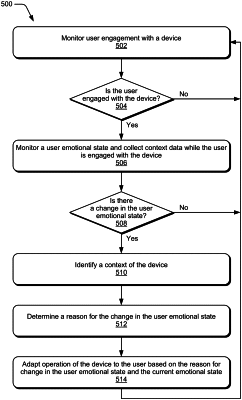| CPC H04L 41/0816 (2013.01) [A61B 5/165 (2013.01); G06F 3/011 (2013.01); G06N 5/04 (2013.01); G06N 20/00 (2019.01); A61B 5/024 (2013.01); A61B 5/1172 (2013.01); G06F 2203/011 (2013.01)] | 20 Claims |

|
1. A method comprising:
monitoring a user emotional state while a user is engaged with a computing device;
detecting that the user emotional state has changed from a first detected emotional state to a current detected emotional state;
identifying a context of the computing device based at least in part on environment data that describes an environment in which the computing device is physically present;
determining, based on the context of the computing device, a reason for the change from the first detected emotional state to the current detected emotional state; and
adapting the computing device to the user by altering operation of the computing device based on the current detected emotional state and the reason for the change from the first detected emotional state to the current detected emotional state.
|